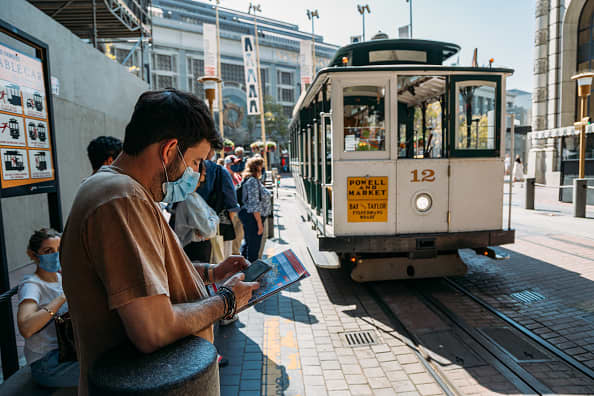National Guard troops pose for photographers on the East Front of the U.S. Capitol the day after the House of Representatives voted to impeach President Donald Trump for the second time January 14, 2021 in Washington, DC.
Chip Somodevilla | Getty Images
In an earnings call this week, Yum Brands CEO David Gibbs expressed the confusion many people are feeling as they try to figure out what’s going on with the U.S. economy right now:
“This is truly one of the most complex environments we’ve ever seen in our industry to operate in. Because we’re not just dealing with economic issues like inflation and lapping stimulus and things like that. But also the social issues of people returning to mobility after lockdown, working from home and just the change in consumer patterns.”
Three months earlier, during the company’s prior call with analysts, Gibbs said economists who call this a “K-shaped recovery,” where high-income consumers are doing fine while lower-income householders struggle, are oversimplifying the situation.
“I don’t know in my career we’ve seen a more complex environment to analyze consumer behavior than what we’re dealing with right now,” he said in May, citing inflation, rising wages and federal stimulus spending that’s still stoking the economy.
At the same time, societal issues like the post-Covid reopening and Russia’s war in Ukraine are weighing on consumer sentiment, which all “makes for a pretty complex environment to figure out how to analyze it and market to consumers,” Gibbs said.
Gibbs is right. Things are very strange. Is a recession coming or not?
There is ample evidence for the “yes” camp.
Tech and finance are bracing for a downturn with hiring slowdowns and job cuts and pleas for more efficiency from workers. The stock market has been on a nine-month slump with the tech-heavy Nasdaq off more than 20% from its November peak and many high-flying tech stocks down 60% or more.
Inflation is causing consumers to spend less on nonessential purchases like clothing so they can afford gas and food. The U.S. economy has contracted for two straight quarters.
San Francisco’s cable cars return to service after COVID-19 shutdown in San Francisco, California, United States on September 21, 2021.
Anibal Martel | Anadolu Agency | Getty Images
Downtown San Francisco doesn’t quite have the ghost town feel it did in February, but still has vast stretches of empty storefronts, few commuters and record-high commercial real estate vacancies, which is also the case in New York (although Manhattan feels a lot more like it’s back to its pre-pandemic hustle).
Then again:
The travel and hospitality industries can’t find enough workers. Travel is back to nearly 2019 levels, although it seems to be cooling as the summer wanes. Delays are common as airlines can’t find enough pilots and there aren’t enough rental cars to satisfy demand.
Restaurants are facing a dire worker shortage. The labor movement is having its biggest year in decades as retail workers at Starbucks and warehouse laborers at Amazon try to use their leverage to extract concessions from their employers. Reddit is filled with threads about people quitting low-paying jobs and abusive employers to … do something else, although it’s not always exactly clear what.
A shrinking economy typically doesn’t come with high inflation and a red-hot labor market.
Here’s my theory as to what’s going on.
The pandemic shock turned 2020 into an epoch-changing year. And much like the 9/11 terrorist attacks in 2001, the full economic and societal effects won’t be understood for years.
Americans experienced the deaths of family members and friends, long-term isolation, job changes and losses, lingering illness, urban crime and property destruction, natural disasters, a presidential election that much of the losing party refuses to accept, and an invasion of Congress by an angry mob, all in under a year.
A lot of people are dealing with that trauma — and the growing suspicion that the future holds more bad news — by ignoring propriety, ignoring societal expectations and even ignoring the harsh realities of their own financial situations. They’re instead seizing the moment and following their whims.
Consumers aren’t acting rationally, and economists can’t make sense of their behavior. It’s not surprising that the CEO of Yum Brands, which owns Taco Bell, KFC and Pizza Hut, can’t either.
Call it the great unrest.
How might that manifest itself? In a decade, how will we look back at the 2020s?
Perhaps:
- Older workers will continue to leave the workforce as soon as they can afford it, spending less over the long term to maintain their independence, and stitching together freelance or part-time work as needed. The labor market will remain tilted toward workers.
- Workers in lower-paying jobs will demand more dignity and higher wages from their employers, and be more willing to switch jobs or quit cold if they don’t get them.
- People will move more for lifestyle and personal reasons rather than to chase jobs. Overstressed workers will continue to flee urban environments for the suburbs and countryside, and exurbs one-to-three hours’ drive from major cities will see an upswing in property values and an influx of residents. Dedicated urban dwellers will find reasons to switch cities, creating more churn and reducing community bonds.
- The last vestiges of employee loyalty will disappear as more people seek fulfillment ahead of pay. As one tech worker who quit her job at Expedia to work for solar tech company Sunrun recently put it, “You just realize there’s a little bit more to life than maxing out your comp package.”
- Employees who proved they could do their jobs remotely will resist coming back to the office, forcing employers to make hybrid workplaces the norm. Spending patterns will change permanently, with businesses catering to commuters and urban workers continuing to struggle.
- Those with disposable income will vigorously spend it on experiences — travel, restaurants, bars, hotels, live music, outdoor living, extreme sports — while curbing the purchase of high-end material goods and in-home entertainment, including broadband internet access and streaming media services. The pandemic was a time to hunker down and upgrade the nest. Now that we’ve got all the furniture and Pelotons we need, it’s time to go out and have fun.
It’s possible that this summer will be the capstone to this period of uncertainty and consumers will suddenly stop spending this fall, sending the U.S. into a recession. Further “black swan” events like wars, natural disasters, a worsening or new pandemic, or more widespread political unrest could similarly squash any signs of life in the economy.
Even so, some of the behavioral and societal shifts that happened during the pandemic will turn out to be permanent.
These signals should become clearer in earnings reports as we move further from the year-ago comparisons with the pandemic-lockdown era, and as interest rates stabilize. Then, we’ll find out which businesses and economic sectors are truly resilient as we enter this new era.
WATCH: Jim Cramer explains why he believes inflation is coming down





